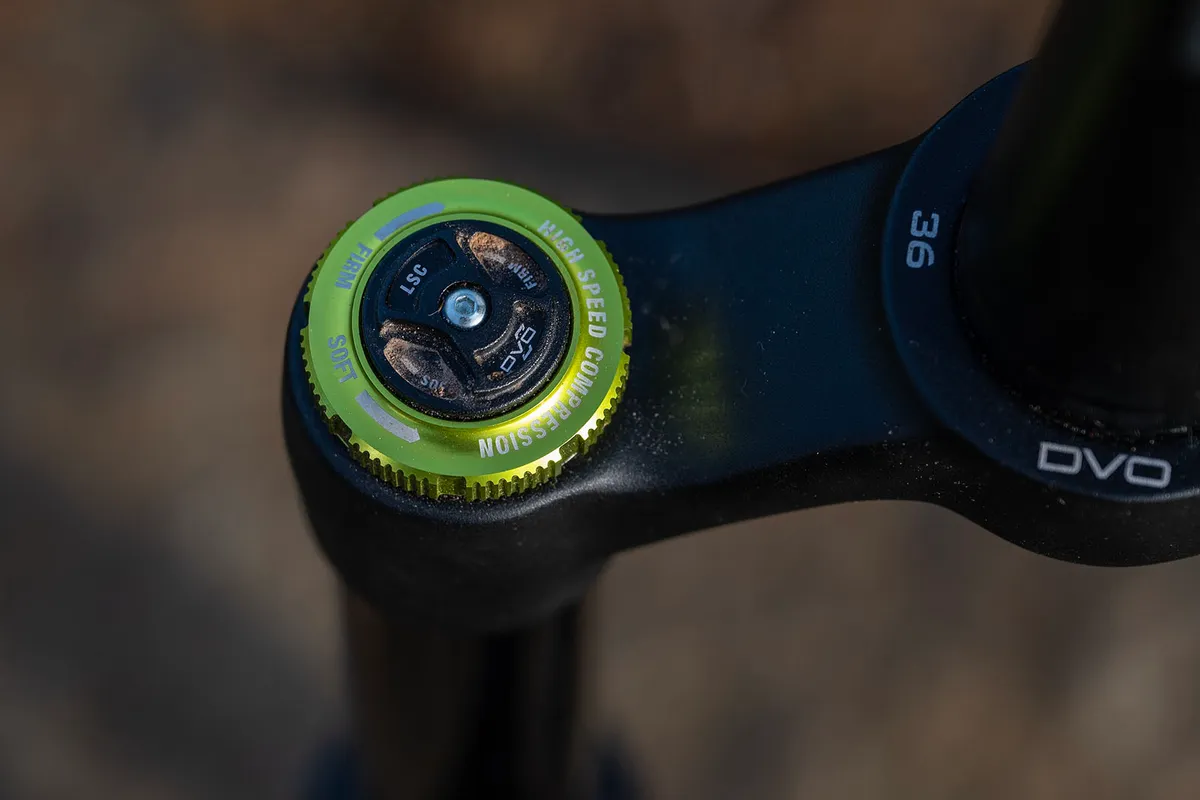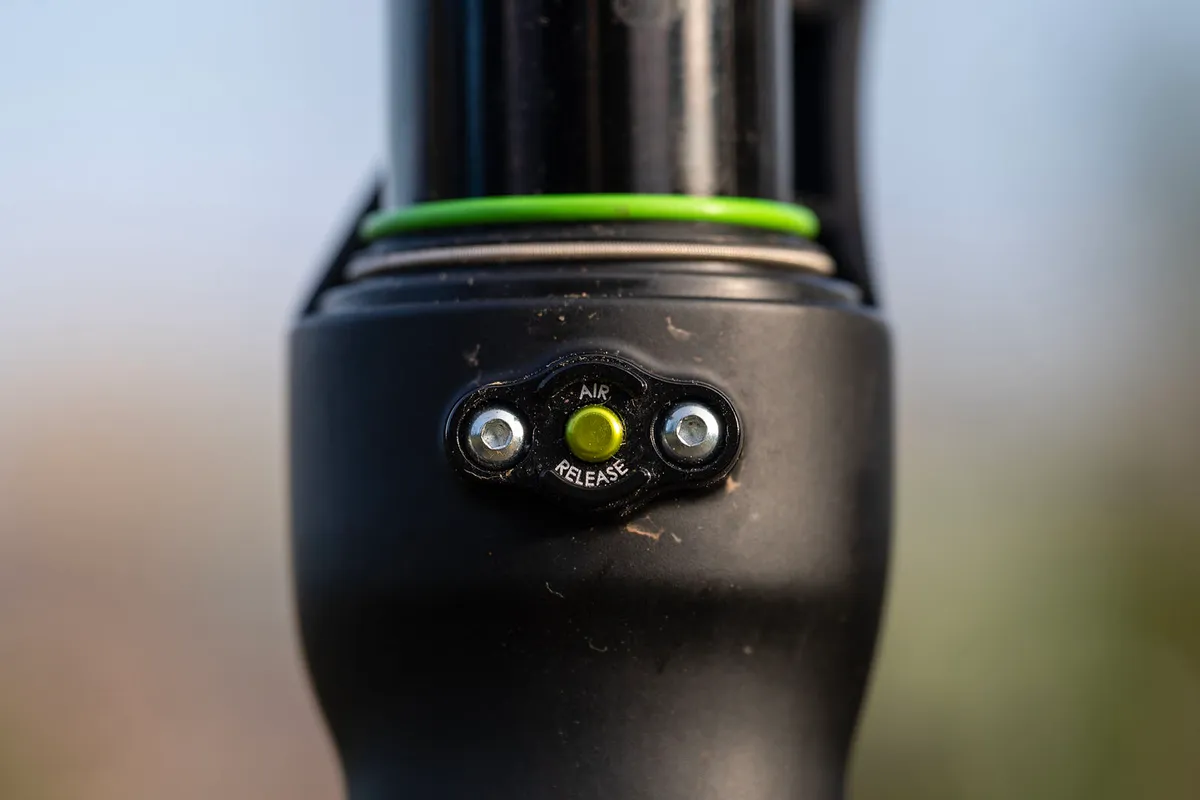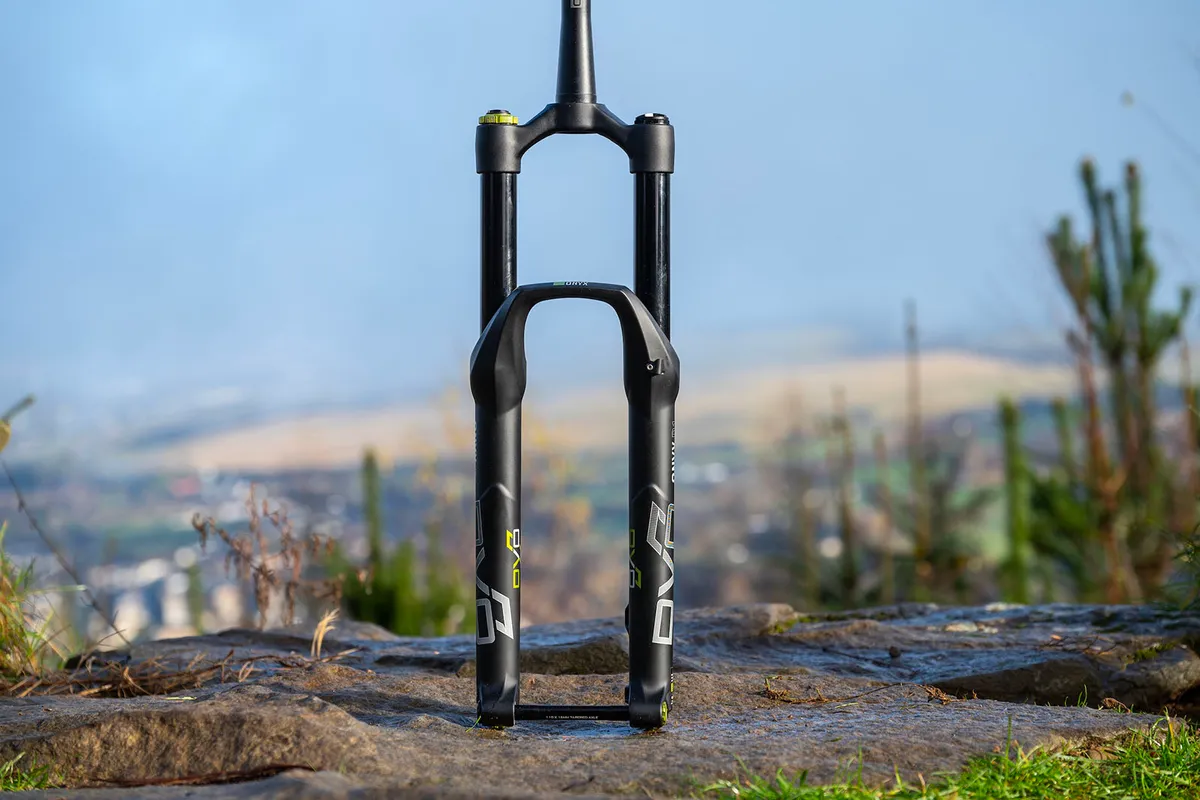The Onyx SC is DVO's most capable single-crown fork and the little brother of the brand's World Cup downhill fork, the Onyx DC (double crown) D1. It's designed to take the enduro world by storm
The 29er-compatible fork on test here packs a serious punch, dishing out 170mm of travel (there are travel options ranging from 160-180mm and 29in or 27.5in forks available). It uses 36mm stanchions.
The Onyx features all the adjustments you'd expect from a top-end fork, including high- and low-speed compression damping and low-speed rebound damping.
There are also air-release valves on the lower legs and the brand's adjustable OTT (Off The Top) negative coil spring.
It uses Boost hub spacing (15x115mm) and a 180mm brake mount. My test fork weighed in at 2.31kg.
DVO Onyx SC D1 details and specifications

Being DVO's burliest and highest-spec single-crown fork, it's not surprising to see the usual adjustments you would expect on a fork of such calibre. What's most interesting is the fork's OTT adjuster.
The fork spring uses an air-filled positive spring and a steel coil negative spring.
This external OTT external adjustment enables you to use a 5mm Allen key to wind preload onto the negative coil spring, effectively increasing the opposing spring force and countering the positive air pressure.
Counter-intuitively, winding on more preload to the OTT gives a suppler ride feel as you increase the force in the negative spring. This is intended to enable you to fine-tune the first 30 per cent of the fork's travel without affecting the mid-stroke or end-stroke progression.
The positive air chamber is filled in the usual manner via a valve at the top of the fork leg. However, DVO controls progression a little differently from other brands.
Instead of installing volume spacers, DVO uses oil in the spring to adjust the spring volume. So, if you want more progression, pour more oil into the positive spring chamber. If you need to remove progression, tip some oil out.
For high-speed compression, DVO measures its adjustments differently from most brands. The brand suggests making changes in full rotations, not on the 28 indexed clicks available. It's advisable to mark a starting point to keep track of the number of rotations. I measured six clicks as one full rotation.
The low-speed compression has a more manageable six clicks that are changeable in the ride if you wish. Position one, the most open, is for descending and technical terrain. Setting six is the firmest, offering the best pedalling platform.
The chassis uses stout 36mm stanchions. The lowers include air-bleeder valves on the back, as found on the latest RockShox and Fox forks. These enable you to release air within the lower legs that may affect ramp-up and overall performance.
A neat touch with this fork is the printed markings on the steerer tube, designed to guide you if you need to cut the steerer shorter.
DVO Onyx SC D1 performance

DVO Onyx SC D1 setup
I settled on 72psi in the positive air chamber, which is at the lower end of DVO's recommended air pressures for my 75kg weight.
I also preferred the feel of the fork with the OTT wound on fully. This is 12 rotations, rather than the nine suggested by DVO's setup guide.
As I do with most forks, I ran the high-speed compression fully open from its 28 available positions. I also ran the low-speed compression damping fully open from its six positions.
I ran the externally adjustable rebound damping fully open too, in order to get the return speeds I wanted. This was 28 clicks from closed, but it was difficult to feel any difference in the rebound speed for the first eight clicks.
DVO Onyx SC D1 ride impressions

On the trail, the DVO has low breakaway force thanks to its Off The Top coil negative spring. Winding on the spring preload fully gave the fork plenty of initial sensitivity, delivering ample ground-hugging traction.
This helps keep the tyre in contact with the trail and reduces vibrations coming through the handlebars over small bumps. A highlight of this fork is its ability to find traction on unsupported corners and over slippery sections of trail, where roots and rocks may push the fork offline.
As you go deeper into the mid-stroke of the travel, the DVO is more supportive than a RockShox ZEB Ultimate Charger 2.1. However, while the fork moves smoothly through its travel to the mid-stroke, I noticed the compression damping returned more feedback to the handlebars over square-edge hits.
That led to more hand ache on longer runs, compared to forks such as the Formula Selva R or Manitou Mezzer Expert.
The DVO doesn't have a harsh spike as it moves deeper into its travel. However, it struggles to be as composed over repeated hits as the best forks I've tested. Through breaking bumps and repeated compressions in rock gardens, the fork isn't the plushest.
On the other hand, it's less firm than the EXT ERA V2. It sits in the middle of the support spectrum.
The middling rebound speeds may lead to some harshness. I ran the rebound fully open to get a quick enough return speed, but it still didn't make the DVO feel that lively.
Over a wide range of trails, the initial-stroke comfort of the DVO is impressive. However, its mid-stroke performance could be better. There are damping forces to overcome in compression and rebound that prevent it from offering the comfort many other forks do.
However, on smoother, faster high-load turns and compressions, as you'll find in the bike park, this gives good support to push against and maintain speed.
With robust 36mm stanchions, the DVO has plenty of authority on the trail. I didn't notice any discernible flex or binding when putting it under high loads. Accuracy in tight sections is good, and it tracks a line well.
How does the DVO Onyx SC D1 compare to the Formula Selva R?

Both of these forks offer features you won't find on more common RockShox and Fox forks, such as the adjustable negative spring. This enables you to tune how sensitive the forks are in the initial portion of their travel.
Both forks offer low breakaway force, which is excellent for maintaining traction.
Deeper in its travel, the Formula offers more comfort and a livelier feel on the trail. Here, it excels at taking the sting out of high-speed impacts, while the DVO is more hesitant to soak up those bigger hits.
The DVO has plenty of support to keep it stable, but transfers more feedback through the handlebars than the Formula. Like all other forks, it misses Formula's party trick of being able to change the compression damping with its CTS systems.
Its light weight, comfort and tunability make the Formula a tough fork to beat.
DVO Onyx SC D1 bottom line

The DVO is a good fork and, while it has decent damping support for those who thrive on charging fast berms and high-load compressions, this support limits its capability over consecutive bumps. It’s not the most comfortable fork available.
That said, winding on the OTT features means you can get a very supple-feeling fork in the initial part of its travel.
How we tested
The best mountain bike suspension forks are a pricey upgrade, but are one of the most important parts of a bike. They influence performance greatly, contributing to handling, comfort and control.
In addition, forks are one of the first big upgrades riders buy, so picking the right one is essential.
We tested seven forks that cover a wide range of price points.
The forks were put through their paces on both the black and rough red trails at BikePark Wales, repeating laps to make testing as consistent as possible.
Forks on test
- Fox 38 Performance Elite review
- DVO ONYX SC D1
- EXT ERA V2
- RockShox ZEB Select review
- Cane Creek Helm MkII
- Manitou Mezza Expert
- Formula Selva R
Product
| Brand | dvo |
| Price | 996.00 GBP |
| Weight | 2.3100, KILOGRAM () - axle included |
Features
| br_spring | air |
| br_lockout | no |
| br_wheelSize | 29in_700c |
| br_axle | 110x15mm bolt-thru |
| br_damperAdjust | External high and low-speed compression, external low-speed rebound |
| br_offset | 44.0000 |
| br_offset | MILLIMETER |
| br_travel | 170.0000 |
| br_travel | MILLIMETER |
| br_stanchionDiameter | 36.0000 |
| br_stanchionDiameter | MILLIMETER |
| Features | Spring: Air-positive chamber, coil-negative spring, OTT (Off the Top) / coil negative: spring preload Brake mount: 180mm Wheel size: 29in, 27.5in Offset: 44mm (29in), 42mm (27.5in) Travel: 160mm – 180mm |
